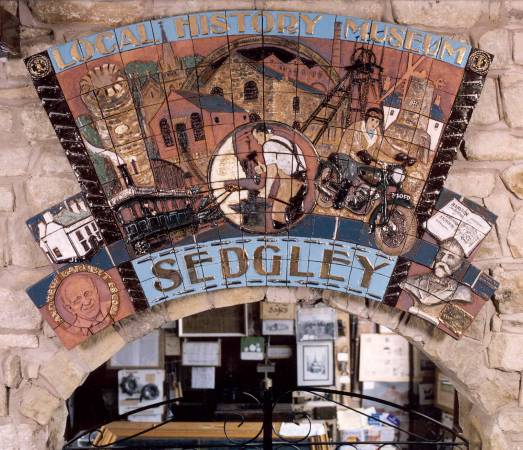
Copyright © Black Country Society
The following description of the mural was written Marjorie Ellis in
1997 and is displayed adjacent to the mural. Here italicised phrases
identify elements of the mural, and bold links indicate elements of the
mural that are described elsewhere on this site.
In the centre of the mural a Sedgley nailer is seen working at his forge, and behind him the Gornal Stone building with a later brick porch is the nail warehouse, which is now home to both the mural itself and the Sedgley Local History Museum.
Around the central panel are incorporated a number of buildings of interest, the most prominent probably being the Beacon Tower. The present tower was [allegedly] built by Lord Wrottesley in 1846, and after his death it was repaired by Thomas Perry, who owned one of the Beacon quarries. It stands on the site of one of the chain of beacons prepared to give warning of the threat of invasion from the Spanish Armada in the sixteenth century. Next to the Beacon Tower is All Saints Church built in 1829. The remains of the tower of an earlier church building are encased within the present tower. Behind the nail warehouse can be seen the chimney and buildings associated with Baggeridge Colliery, which closed on Friday 1st March 1968. The pit-head gear is also depicted, and Ruiton Windmill completes the panorama.
In front of the buildings, local transport is represented by a steam tram and the DMW motor cycle which was manufactured in Sedgley at the old Tram Depot near Moden Hill.
The borders are decorated with two local products: nails and pen nibs. Daniel Fellows and his apprentice Thomas Sheldon claim to have invented steel pen nibs, and were certainly making them here early in the nineteenth century. Thomas Sheldon was licensee of one of our public houses, possibly The Swan. The seal of Sedgley Urban District Council which can be seen in the top corners included two pen nibs in its design. Another local product was the coffee mill.
The mural also includes the names of Dud Dudley who claims to have been the first to smelt iron using coal instead of charcoal; Abraham Darby who was born at Wrens Nest House on the Old Park (between Sedgley and Dudley) but is more well-known by his association with Ironbridge, and Daniel Fellows who was involved with Thomas Sheldon in the manufacture of pen nibs.
The wings on either side of the main panel include the Court House, now just another public house but originally the home of Lord Dudley's Manorial Court, or Court Baron, and of the annual Court Leet, at which officers were appointed for the following year. Also on these side wings are memorials of three famous local men:
Joseph Nicholds composed a number of well-known musical items of which the most famous is the oratorio Babylon. He was born at The Coppice, Hurst Hill, in 1784 and died in Dudley in 1860. An incised slab is all that now remains of the memorial erected in his memory, but it can still be seen near a bench in the burial ground off Vicar Street.
Dr Isaiah J. Baker was a much-loved medical practitioner in Hurst Hill, where a stone column is topped by a portrait bust that served as a model for this illustration. He died in August 1912 and the memorial was unveiled in 1914.
The portrait in the lower left-hand corner is
of Mr F. Andrew Barnett,
founder of Sedgley Local History Society and of this museum. He died in
1989, less than a year after the museum opened.
The mural was designed and made in Sedgley by Mr William Burgess and
was unveiled on January 9th 1997 by Mr Keith Thompson of Cottage
Blinds, The Old Nail Works, Brick Street, Sedgley.
The photograph of the mural is used by kind permission of The Black Country Society and was taken by Graham Beckley, the Society's own photographer, in 1997.
